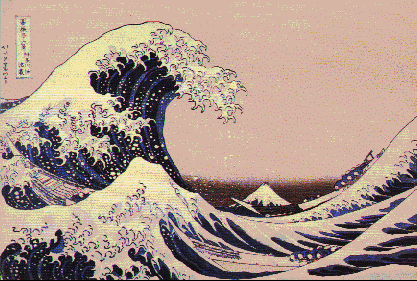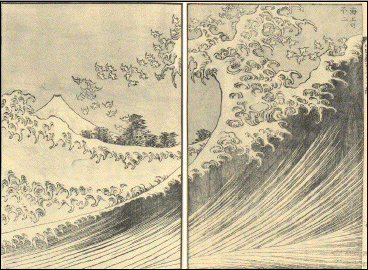 |
 |
 |
 |
| ||
| Perhaps best known in the west for In the Hollow of a wave off the coast of Kanagawa (left), also called The great wave, from Thirty-Six Views of Mt. Fuji, in the 1830s and 40s the Japanese artist Hokusai made wonderful woodblock prints that present fractal aspects of nature with a sophistication rarely matched even today. | ||
| Immediately after the 36 views, Hokusai made One Hundred Views of Mt. Fuji. Three of these are shown here. | ||
| On the left above is Fuji from the Seashore. Click for an enlargement in a new window. | ||
| Note the seaweed pattern, and compare it with a filled-in Julia set, for example. | ||
| Hokusai saw these patterns in nature, but they certainly remind us of the intricate detail of Julia sets. Perhaps this is one of the reasons Julia sets are so attractive: these mathematical fractals mimick some of the intricacy familiar from nature. | ||
| On the left below Fuji at Sea. Click the picture for an enlargement in a new window. | ||
| Note the fractal structure of the waves, and the Escheresque transition of waves to birds. | ||
| In The great wave the wave moves left to right, opposite the usual Japanese reading of a picture from right to left. In Fuji at Sea both wave and birds move harmoniously. | ||
| ||
| On the right above is Fuji in a Thunderstorm. Click the picture for an enlargement in a new window. | ||
| Note the wriggles upon wriggles upon wriggles of the clouds and also of the profiles of the trees. | ||
| The broken lines on the left panel represent lightning. | ||
| Comparing these clumsy strokes to the wonderful observational detail in other parts of this picture is striking. How could such a subtle observer of nature have drawn so crude a representation of lightning? | ||
| Jennifer Lanski reminded us that Hokusai worked before photography had been developed. So he had only brief, visual inspection of lightning to guide his drawing. Long, careful inspection applicable to trees and clouds was not available for the study of lightning. |